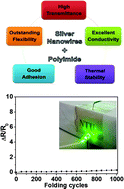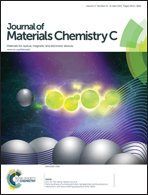Highly transparent and flexible polyimide–AgNW hybrid electrodes with excellent thermal stability for electrochromic applications and defogging devices†
Abstract
In this study, highly transparent and flexible electrodes with the highest thermal stability were successfully prepared from silver nanowire (AgNW)–polyimide (PI) hybrid solutions by facile solution casting on insoluble polyimide substrates without any troublesome transferring process. The prepared highly flexible AgNW–PI electrodes exhibit a low resistance of 25 Ω sq−1 and high transmittance up to 86% at a wavelength of 550 nm. Thus, by introducing high performance polyimide as a binder, the obtained colorless AgNW electrodes show improved adhesion properties between the AgNWs and the substrates as well as excellent thermal stabilities and high glass transition temperatures (Tg) above 300 °C. Furthermore, the resulting AgNW–PI hybrid colorless electrodes could maintain the conductivity even after folding more than 1000 times. Thus, these optically transparent AgNW–PI hybrid electrodes have extremely high potential to operate at high temperatures in the working environment or post processing.


 Please wait while we load your content...
Please wait while we load your content...